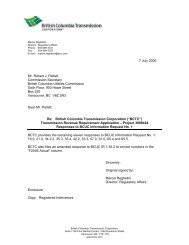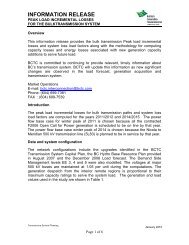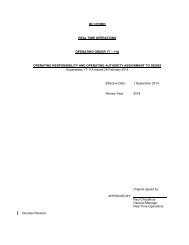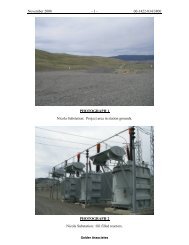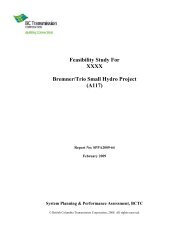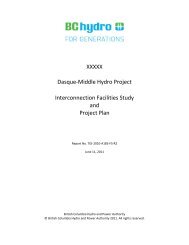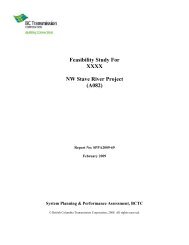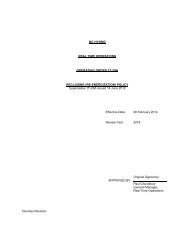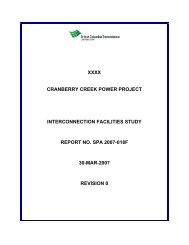Evidence on the Adequacy of First Nations Consultation - BC Hydro ...
Evidence on the Adequacy of First Nations Consultation - BC Hydro ...
Evidence on the Adequacy of First Nations Consultation - BC Hydro ...
Create successful ePaper yourself
Turn your PDF publications into a flip-book with our unique Google optimized e-Paper software.
The above summary <strong>of</strong> <strong>the</strong> traditi<strong>on</strong>al districts within <strong>the</strong> Ktunaxa territory in British Columbia<br />
indicates that <strong>the</strong> proposed CVT line lies in <strong>the</strong> Land <strong>of</strong> <strong>the</strong> Eagle.<br />
Newcomers to <strong>the</strong> Kootenays noted that <strong>the</strong> Ktunaxa spoke <strong>the</strong> same language throughout this area,<br />
but <strong>on</strong>e very different to that <strong>of</strong> surrounding tribes. Despite this, <strong>the</strong>y saw evident differences in <strong>the</strong>ir<br />
material ec<strong>on</strong>omy, enough to generate <strong>the</strong> distincti<strong>on</strong>s <strong>of</strong> Upper Kootenay, centred around <strong>the</strong> Upper<br />
Columbia and Upper Kootenai valleys, and <strong>the</strong> Lower Kootenay whose focus lay more to <strong>the</strong> south<br />
and west nearer Kootenay Lake and <strong>the</strong> c<strong>on</strong>fluence <strong>of</strong> <strong>the</strong> Kootenay and Columbia Rivers.<br />
Ktunaxa appears to be a language isolate, essentially unrelated to surrounding languages. Some<br />
scholars have suggested that <strong>the</strong>re are special elements in <strong>the</strong> language that appear to c<strong>on</strong>nect it with<br />
<strong>on</strong>ly <strong>the</strong> Alg<strong>on</strong>quin language group to <strong>the</strong> east, which interestingly includes <strong>the</strong>ir traditi<strong>on</strong>al enemies<br />
<strong>the</strong> Blackfeet. O<strong>the</strong>rs have suggested that it has a different type <strong>of</strong> c<strong>on</strong>necti<strong>on</strong> with Salish languages.<br />
The linguist Mat<strong>the</strong>w Dryer assessed <strong>the</strong>se possible c<strong>on</strong>necti<strong>on</strong>s and c<strong>on</strong>cluded that <strong>the</strong> similarities<br />
with Alg<strong>on</strong>quin languages which he describes as “quirky features” are highly specific and likely due<br />
to later c<strong>on</strong>tact, not a comm<strong>on</strong> “genetic” inheritance. 9 He finds <strong>the</strong> c<strong>on</strong>necti<strong>on</strong> <strong>of</strong> Ktunaxa to<br />
Salishan languages less c<strong>on</strong>vincing, pointing out that more general typological similarities indicate a<br />
comm<strong>on</strong> inheritance is possible but not very useful since that c<strong>on</strong>necti<strong>on</strong> would actually apply to<br />
most tribes in <strong>the</strong> Pacific Northwest.<br />
This situati<strong>on</strong> has interesting parallels in Europe, for example, in <strong>the</strong> Hungarian and Basque<br />
languages. Both are language isolates, and both are spoken by people who have seen vast migrati<strong>on</strong>s<br />
<strong>of</strong> people moving around <strong>the</strong>m through <strong>the</strong> past several millennia but have retained <strong>the</strong>ir ancient<br />
languages, probably because <strong>of</strong> <strong>the</strong>ir homeland’s mountainous geography. Similarly, a likely<br />
explanati<strong>on</strong> for <strong>the</strong> isolate nature <strong>of</strong> <strong>the</strong> Ktunaxa language is that <strong>the</strong>se people have been in <strong>the</strong>ir<br />
mountainous Kootenay enclave for at least several millennia, while <strong>the</strong> evoluti<strong>on</strong> and movement <strong>of</strong><br />
o<strong>the</strong>r language groups has swirled around <strong>the</strong>m. As <strong>the</strong> Royal Engineer and Surveyor Charles<br />
Wils<strong>on</strong> observed in <strong>the</strong> 1850s, this tribe “is entirely isolated, and has had far less intercourse with <strong>the</strong><br />
whites than any o<strong>the</strong>r surrounding tribe."<br />
6. ARCHAEOLOGICAL ASSESSMENTS RELATING TO KTUNAXA PRESENCE<br />
Archaeological evidence also suggests that <strong>the</strong> ancestors <strong>of</strong> present-day Ktunaxa have inhabited <strong>the</strong><br />
Columbia Plateau for many thousands <strong>of</strong> years. Archaeologist Wayne Choquette has noted that<br />
archaeological sites throughout <strong>the</strong> Columbia Plateau in <strong>the</strong> period 5,000 to 2,500 years ago c<strong>on</strong>tain<br />
implements made <strong>of</strong> <strong>the</strong> distinctive grey-green argillite found in <strong>the</strong> Kootenay Lake area: 10<br />
The abundant representati<strong>on</strong> <strong>of</strong> <strong>the</strong> distinctive Kootenay Argillite in archaeological sites around<br />
Crest<strong>on</strong>, in nor<strong>the</strong>rn Idaho, and as far up <strong>the</strong> Kootenay River as <strong>the</strong> Libby, M<strong>on</strong>tana vicinity makes it<br />
clear that <strong>the</strong> north arm <strong>of</strong> Kootenay Lake was an important part <strong>of</strong> <strong>the</strong> aboriginal seas<strong>on</strong>al round. This<br />
appears to have been especially <strong>the</strong> case between about 5000 and 2500 years ago when Kootenay<br />
Argillite attained its highest proporti<strong>on</strong>s in upriver artefact assemblages. In o<strong>the</strong>r parts <strong>of</strong> <strong>the</strong> regi<strong>on</strong>,<br />
this time period is characterized by a greater orientati<strong>on</strong> to <strong>the</strong> resources <strong>of</strong> aquatic and riparian habitats<br />
by <strong>the</strong> resident human populati<strong>on</strong>s…<br />
9 Dryer, Mat<strong>the</strong>w S. Kutenai, Alg<strong>on</strong>quian, and <strong>the</strong> Pacific Northwest from an Areal Perspective<br />
10 Choquette, 2005, pp. 13-15<br />
8<br />
Page 152 <strong>of</strong> 200






